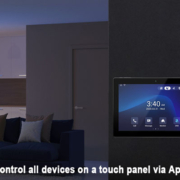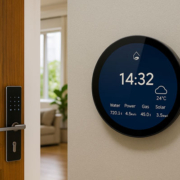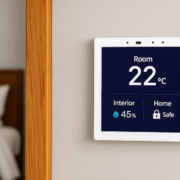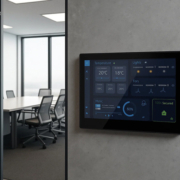How Many Apps Do I Need to Control My Smart Home?
Smart homes have revolutionized how we interact with our living spaces — from voice-activated lights to app-controlled thermostats and security cameras. But with the growing number of smart devices comes an important question: How many apps do I actually need to control my smart home?
The answer isn’t always simple. It depends on the devices you choose, their compatibility, and whether your smart home is built around a centralized control system — such as a smart home control panel.
In this article, we’ll explore how app fragmentation affects the smart home experience, ways to reduce app overload, and how all-in-one solutions like Portworld smart control panels can simplify everything.
The Problem: App Overload in Smart Homes
Most smart home devices come with their own dedicated app:
- Smart bulbs (e.g., Philips Hue)
- Thermostats (e.g., Nest or ecobee)
- Security cameras (e.g., Ring, Arlo)
- Door locks (e.g., August, Yale)
- Smart plugs and outlets (e.g., TP-Link Kasa)
- Speakers and voice assistants (e.g., Alexa, Google Home)
- Robot vacuums, sprinklers, garage doors — the list goes on
On average, homeowners use 5 to 10 different apps to control all their smart home devices — which can be frustrating, especially when apps don’t talk to each other or require separate logins and settings.
Option 1: Multiple Apps — Fragmented but Flexible
Using separate apps for each device can be useful in the following cases:
- You prefer brand-specific features that only their app supports
- Your devices are not compatible with a common platform
- You’re fine with switching between apps to access advanced settings
But this approach also means:
- More notifications, more updates, more accounts
- Increased complexity when adding new users or devices
- A cluttered phone and less intuitive daily control
Option 2: One App to Rule Them All — Ecosystem Integration
For a smoother experience, many users turn to hub platforms or integrated apps:
Popular All-in-One Smart Home Apps:
- Apple Home (HomeKit)
- Google Home
- Amazon Alexa
- Samsung SmartThings
- Home Assistant (DIY/open-source)
These apps let you control multiple device types in one place, create automation scenes, and integrate voice control. However, limitations still exist:
- Not all brands support all ecosystems
- Some integrations are basic (e.g., on/off, no deep settings)
- Compatibility depends on certifications (like “Works with Alexa”)
Option 3: Smart Home Control Panels — Centralized & Seamless
If you’re tired of juggling apps or relying on cloud-based voice assistants, the best solution might be a smart home control panel — a wall-mounted or tablet-style interface that centralizes all device control, either through local processing or app aggregation.
Why Smart Control Panels Are Better:
- No need to unlock your phone or switch apps
- Local and secure access (works even if your Wi-Fi is down)
- Easier for guests, children, and elderly to use
- Can integrate with apps, hubs, and voice assistants
Portworld: Simplifying Control with Smart Panels
Portworld offers highly customizable Android-based smart home control panels that let you integrate and control your entire ecosystem from a single screen.
Key Features:
- Runs multiple apps in one panel: Install Google Home, Alexa, SmartThings, and more
- Custom UI options: Combine different systems under a unified interface
- Voice assistant integration: Supports Google Assistant or Alexa
- POE-powered options for clean, cable-free installation
- Compact 4-inch and 5-inch models ideal for room-by-room use
You can use your Portworld smart control panel to:
- Launch and switch between apps like a smartphone
- Automate your home with customized scenes
- Monitor energy, air quality, and security
- Manage multi-room audio or video systems
Final Thoughts: How Many Apps Do You Really Need?
Ideally, just one — the one that works across all your devices and platforms.
In reality, most users will need 2–3 apps minimum:
- One for core devices (like Google Home or SmartThings)
- One for specialty devices (e.g., your security brand)
- One for advanced configuration or brand-specific tools
But with solutions like Portworld’s smart home control panels, you can eliminate the constant app juggling and streamline everything into one clean, intuitive interface — fixed in your wall and always ready.








